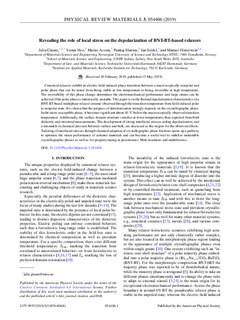| dc.contributor.author | Glaum, Julia | |
| dc.contributor.author | Heo, Yooun | |
| dc.contributor.author | Acosta, Matias | |
| dc.contributor.author | Sharma, Pankaj | |
| dc.contributor.author | Seidel, Jan | |
| dc.contributor.author | Hinterstein, Manuel | |
| dc.date.accessioned | 2019-06-24T14:31:20Z | |
| dc.date.available | 2019-06-24T14:31:20Z | |
| dc.date.created | 2019-06-24T11:37:37Z | |
| dc.date.issued | 2019 | |
| dc.identifier.citation | PHYSICAL REVIEW MATERIALS. 2019, 3 054406-1-054406-8. | nb_NO |
| dc.identifier.issn | 2475-9953 | |
| dc.identifier.uri | http://hdl.handle.net/11250/2601931 | |
| dc.description.abstract | Canonical relaxors exhibit an electric-field-induced phase transition between a macroscopically nonpolar and polar phase that can be tuned from being stable at low temperature to being reversible at high temperature. The reversibility of this phase change determines the electromechanical performance and large strains can be achieved if the polar phase is intrinsically unstable. This paper is on the thermal depolarization characteristics of a BNT-BT-based multiphase relaxor ceramic observed through the transition temperature from field-induced polar to nonpolar state. It is shown that the progress of detexturization strongly depends on the crystallographic phase. In the more susceptible phase, it becomes significant about 40 °C below the macroscopically observed transition temperature. Additionally, the surface domain structure vanishes at lower temperatures than expected from both dielectric and structural measurements. The development of strong interfacial stresses aiding depolarization, and a mismatch in chemical pressure between surface and bulk, are discussed as the origins for the observed effects. Tailoring of interfacial stresses through chemical adaption of crystallographic phase fractions opens up a pathway to optimize the strain performance of actuator materials and can become a useful tool to stabilize metastable crystallographic phases as well as for property tuning in piezotronics, Mott insulators and multiferroics. | nb_NO |
| dc.language.iso | eng | nb_NO |
| dc.publisher | American Physical Society | nb_NO |
| dc.rights | Navngivelse 4.0 Internasjonal | * |
| dc.rights.uri | http://creativecommons.org/licenses/by/4.0/deed.no | * |
| dc.title | Revealing the role of local stress on the depolarization of BNT-BT-based relaxors | nb_NO |
| dc.type | Journal article | nb_NO |
| dc.type | Peer reviewed | nb_NO |
| dc.description.version | publishedVersion | nb_NO |
| dc.source.pagenumber | 054406-1-054406-8 | nb_NO |
| dc.source.volume | 3 | nb_NO |
| dc.source.journal | PHYSICAL REVIEW MATERIALS | nb_NO |
| dc.identifier.doi | 10.1103/PhysRevMaterials.3.054406 | |
| dc.identifier.cristin | 1707200 | |
| dc.description.localcode | Published by the American Physical Society under the terms of the Creative Commons Attribution 4.0 International license. Further distribution of this work must maintain attribution to the author(s) and the published article’s title, journal citation, and DOI. | nb_NO |
| cristin.unitcode | 194,66,35,0 | |
| cristin.unitname | Institutt for materialteknologi | |
| cristin.ispublished | true | |
| cristin.qualitycode | 1 | |

